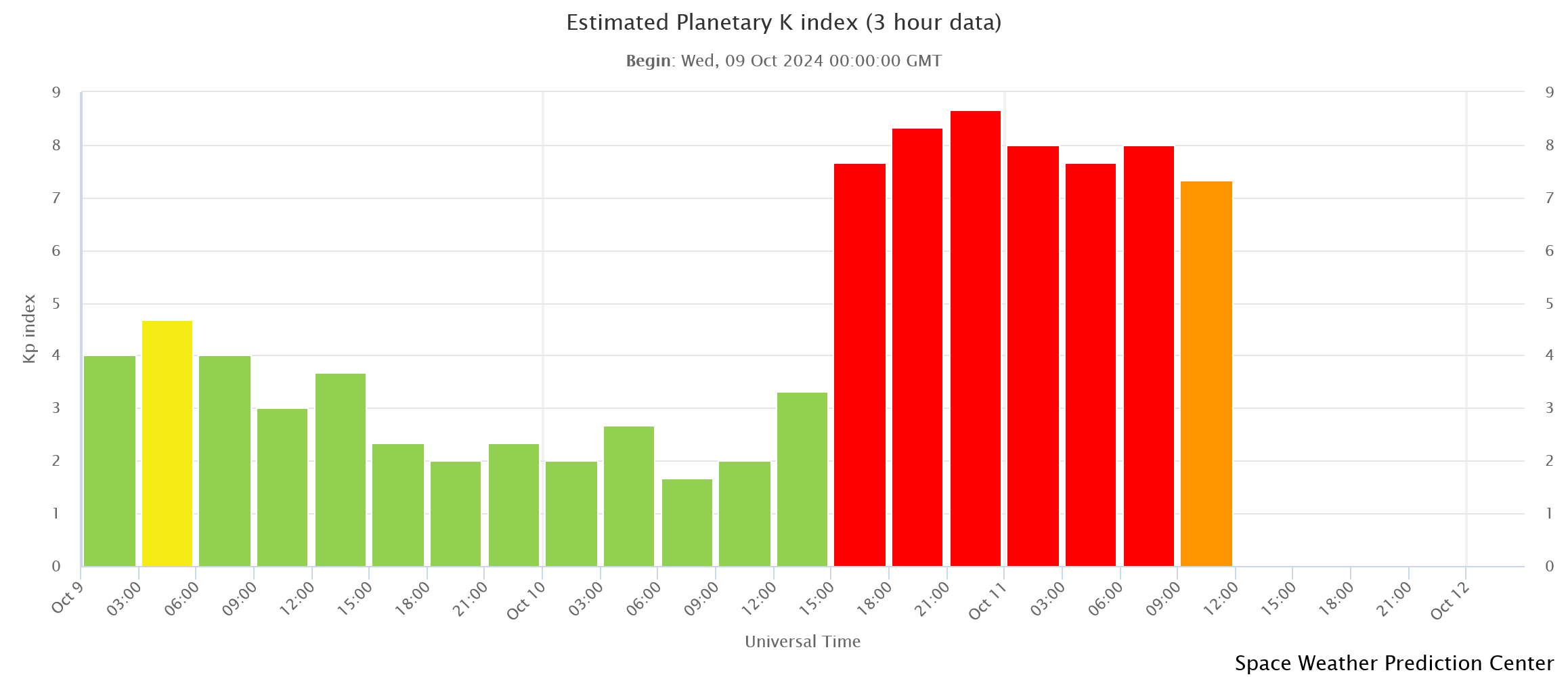UPDATED - Please scroll down
NOAA 3848 has been one of the largest sunspot groups on disk during last week, but was all in all relatively quiet... until today that is. Early in the UTC day, it produced a long duration X1.8 solar flare peaking on 9 October at 01:56UTC (GOES). Underneath is an overlay of extreme ultraviolet imagery (SDO/AIA 131) on top of white light imagery (SDO/HMI) highlighting the strength of the flare and its location with respect to sunspot region NOAA 3848. The blooming and diffraction patterns that can be seen in this image are instrumental (more information is in Note 1 of this STCE newsitem). The X-class flare affected HF communications (3-30 MHz) mainly over Japan, China, southeast Asia, Australia and the Mid- and West-Pacific Ocean. An advisory to civil aviation has been issued (CRC, PECASUS).

The greater than 10 MeV proton flux quickly started to increase and passed the alert threshold of 10 pfu at 05:05UTC (GOES). It reached 1000 pfu at 12:40UTC, meaning that a solar radiation storm of strong intensity ("S3" - see the NOAA scales) is in progress. Degraded HF radio propagation (3-30 MHz) through the polar regions are likely (Polar Cap Absorption). Also the greater than 100 MeV proton flux reached its alert threshold (1 pfu at 03:50UTC), however the greater than 500 MeV proton flux remained at background levels, suggesting there's no Ground Level Enhancement (GLE) in the offing. UPDATE: At 15:15UTC on 10 October, the proton flux reached a value of 1810 pfu, coinciding with the passage of the interplanetary CME. This value makes it the strongest proton event so far this solar cycle (SC25).
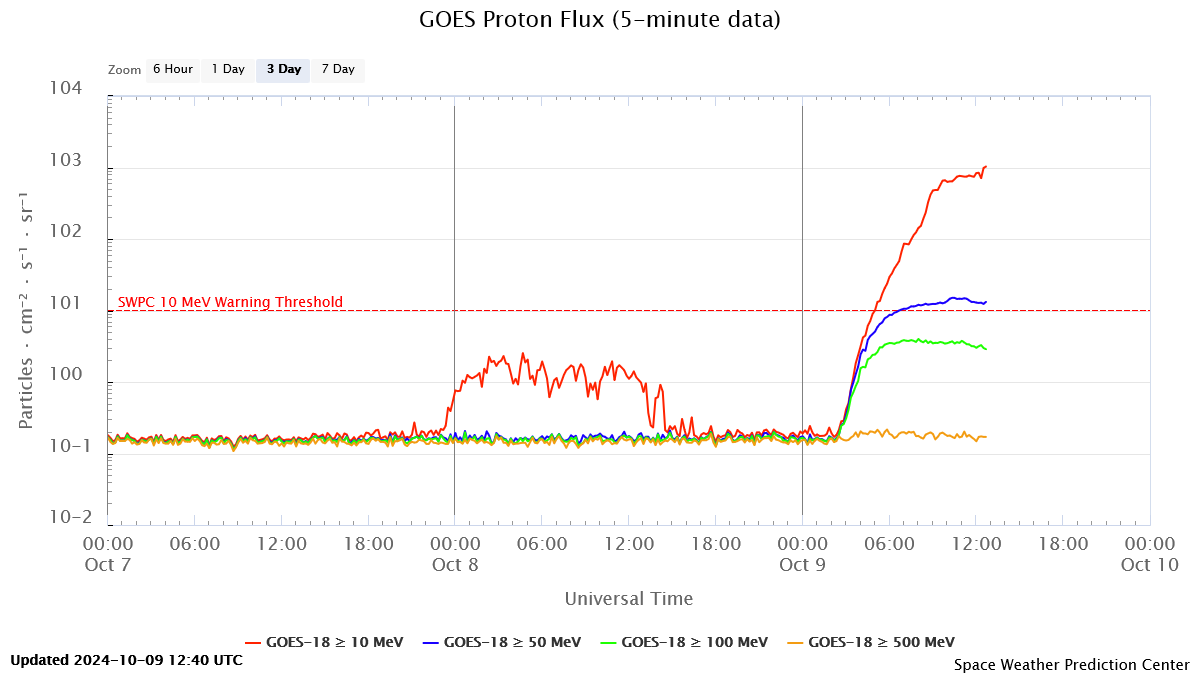
The flaring event was also the source of a strong radio disturbance at all observed frequencies (NOAA/USAF network). At GNSS frequencies, the radio burst reached 70.000 sfu (1415 MHz) and at 610 MHz 61.000 sfu. Much higher values have been recorded in the past, but this still is not your every-day event. Radio observatories also recorded specific radio bursts as shown in the collage underneath of radio spectrograms obtained by ASSA in Australia. It shows a Type III burst at 01:42UTC, a strong Type II burst between 01:45 and 02:00UTC followed by a Type IV burst that lasted until 04:00UTC (see the STCE SWX Classification page for more info on this kind of bursts ).

The Type II radio burst already indicated that a coronal mass ejection (CME) was associated with this X1 flare. Coronagraphic imagery by SOHO and STEREO-A show a full halo CME first seen at 02:30UTC in LASCO/C3. The clip underneath shows the evolution of the CME. The feature in the right of the field of view is comet Tsuchinshan–ATLAS that will become visible in the evening sky of the Earth's northern hemisphere in the coming days. Also the impact of the energetic protons on the camera's pixels can be seen as an increase in noise on the image. The observed CME is directed to Earth, with an arrival at Earth during the second half of 10 October (+/- 12h). The SIDC forecaster expects a geomagnetic storm that may reach moderate to severe levels (Kp = 6 to 8). In case of a severe geomagnetic storm and weather permitting, aurora may be photographed from Belgium. Visually, there's a chance to observe the aurora low at the northern horizon during the night of 10-11 October. However, even with Kp = 8, it will be far from the stunning spectacle as seen in May this year when Kp reached 9.
Further strong flaring from NOAA 3848 over the next few days is possible, with a chance on an earth-directed CME as well as on another proton event.
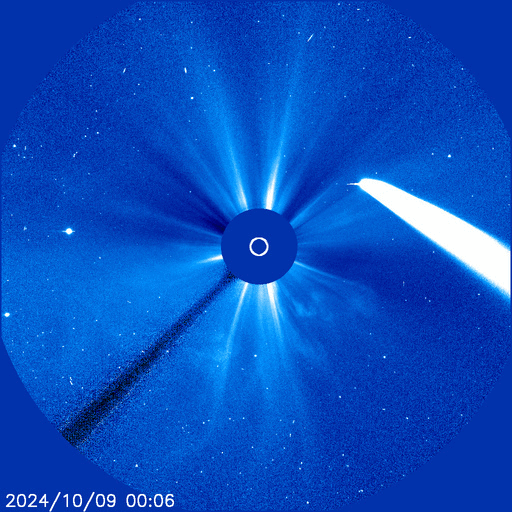
UPDATES
UPDATE 10 October 2024 at 16:30UTC - The interplanetary coronal mass ejection (ICME) associated with the X1.8 flare arrived around 14:48UTC on 10 October 2024. The timing is very well within the expectations by the SIDC SWx forecasters. Solar wind speed jumped from 460 km/s to near 800 km/s as measured by the DSCOVR and ACE satellites (yellow curve in map underneath).
Note that from their location in space, it still takes the ICME another 30 minutes before it actually reaches the earth environment. A jolt in the local magnetic field was observed at Dourbes Belgium (BGS/Intermagnet), with an increase of 75 nT at 15:16UTC. This is a strong value, but only about half as strong as the storm sudden commencement observed during the 10-11 May 2024 storm (initial jump of about 165 nT).
For the further evolution of this geomagnetic storm, it is especially the Bz value (strength of the vertical component of the interplanetery magnetic field - red curve-) that is to be watched. For a Kp value of 8 or 9, not only is a Bz of about -30 nT or stronger (more negative) required, these strongly negative values need to be maintained for several consecutive hours. For example, during the 10-11 May storm, Bz varied between -40 and -50 nT for 3 hours.
For the current geomagnetic storm, Bz reached -26 nT at 15:14UTC and has been at -25 nT since around 15:35UTC, gradually decreasing. So, based on these initial observations of the passing CME, a Kp of 8 is possible, but for a Kp of 9 one would expect a stronger (and long-lasting) Bz. So, in case of a severe geomagnetic storm (Kp = 8) and weather permitting, aurora may be photographed from Belgium. Visually, there's a chance to observe the aurora low at the northern horizon during the night of 10-11 October. However, in order to have a stunning spectacle such as seen in May this year, Kp needs to reach 9.
At 16:15UTC, the estimated Kp (NOAA) was at 7, the Potsdam Kp was at 6+, and the local K index in Belgium (K_BEL, Dourbes) was at 5. It is almost certain these values will increase as the earth environment enters the core of the ICME and the geomagnetic storm further develops.
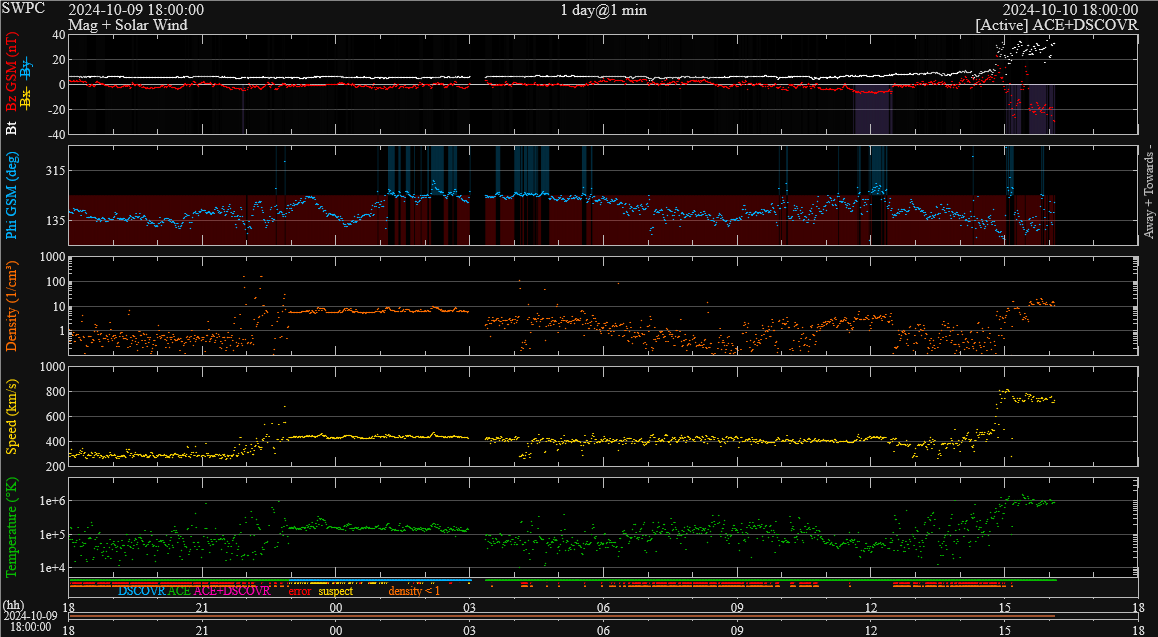
UPDATE - 10 October 2024 at 21:30UTC - Since 17:00UTC, Bz has been mostly negative and varying between -15 nT and -25 nT (DSCOVR). During the 15-18UTC interval; the estimated Kp (NOAA) and the Potsdam Kp reached a value of 8-, and during the 18-21UTC interval both indices reached 8+, consistent with a severe geomagnetic storm. The local K index in Belgium (K_BEL, Dourbes) was at 7 (strong storm).The provisional Dst index has reached -206 nT (Kyoto WDC), making it one of the strongest storms so far this solar cycle. For a comparison, Dst reached -412 nT during the 10-11 May storm. Further severe geomagnetic storming is expected, with a small chance on an extremely severe storm should Bz reach more negative values.
Aurora have already been well observed from the Netherlands, and photographed through cloud breaks from Belgium (HLN, VRT). Long exposure photographs showed the red aurora were also visible from France, Switzerland, and Hungary (Spaceweather.com).
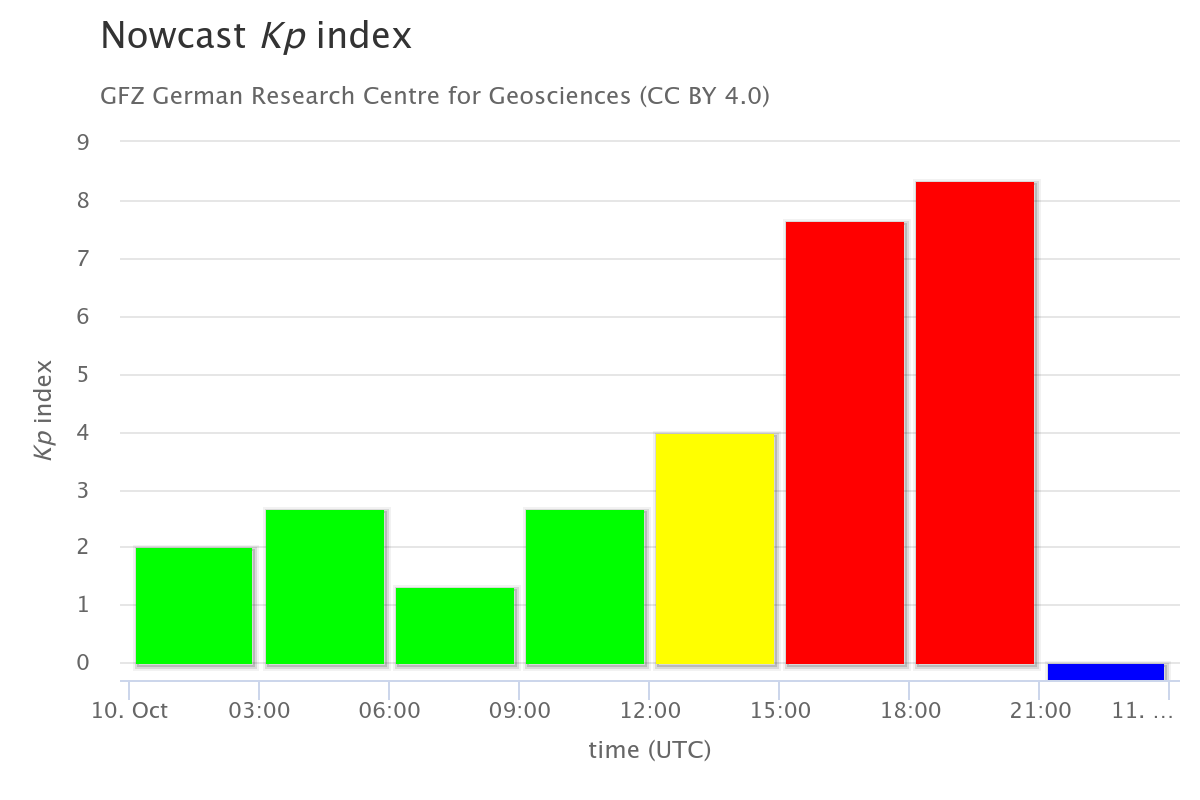
UPDATE - 11 October 2024 at 00:15UTC - After a strong start, the ongoing geomagnetic storm shifted into an even higher gear as apparently the core of the ICME passed the earth environment. From 22:00UTC onwards, Bz has been steady between -40nT and -45 nT (DSCOVR). As a result, the estimated Kp (NOAA) and the Potsdam Kp reached a value of 9- during the 21-24UTC interval. Technically this is still a severe geomagnetic storm (NOAA scales), but we are getting really close now to extremely severe storming levels (Kp=9o). The local K index in Belgium (K_BEL, Dourbes) remained at 7 (strong storm).The provisional Dst index has reached -310 nT during the 23-24UTC interval (Kyoto WDC), making it the all but one strongest storm so far this solar cycle, after the 10-11 May storm earlier this year (Dst = -412 nT). Further (extremely) severe geomagnetic storming is expected, pending the further evolution of Bz.
Aurora have already been well observed from the Netherlands and Germany, and photographed through cloud breaks from Belgium (HLN, VRT). Long exposure photographs showed the red aurora were also visible from France, Switzerland, Italy and Hungary (Spaceweather.com).
Underneath is a view on the aurora from Hoogstraten, Belgium before clouds started to roll in (Credits: Santiago Andres Triana).
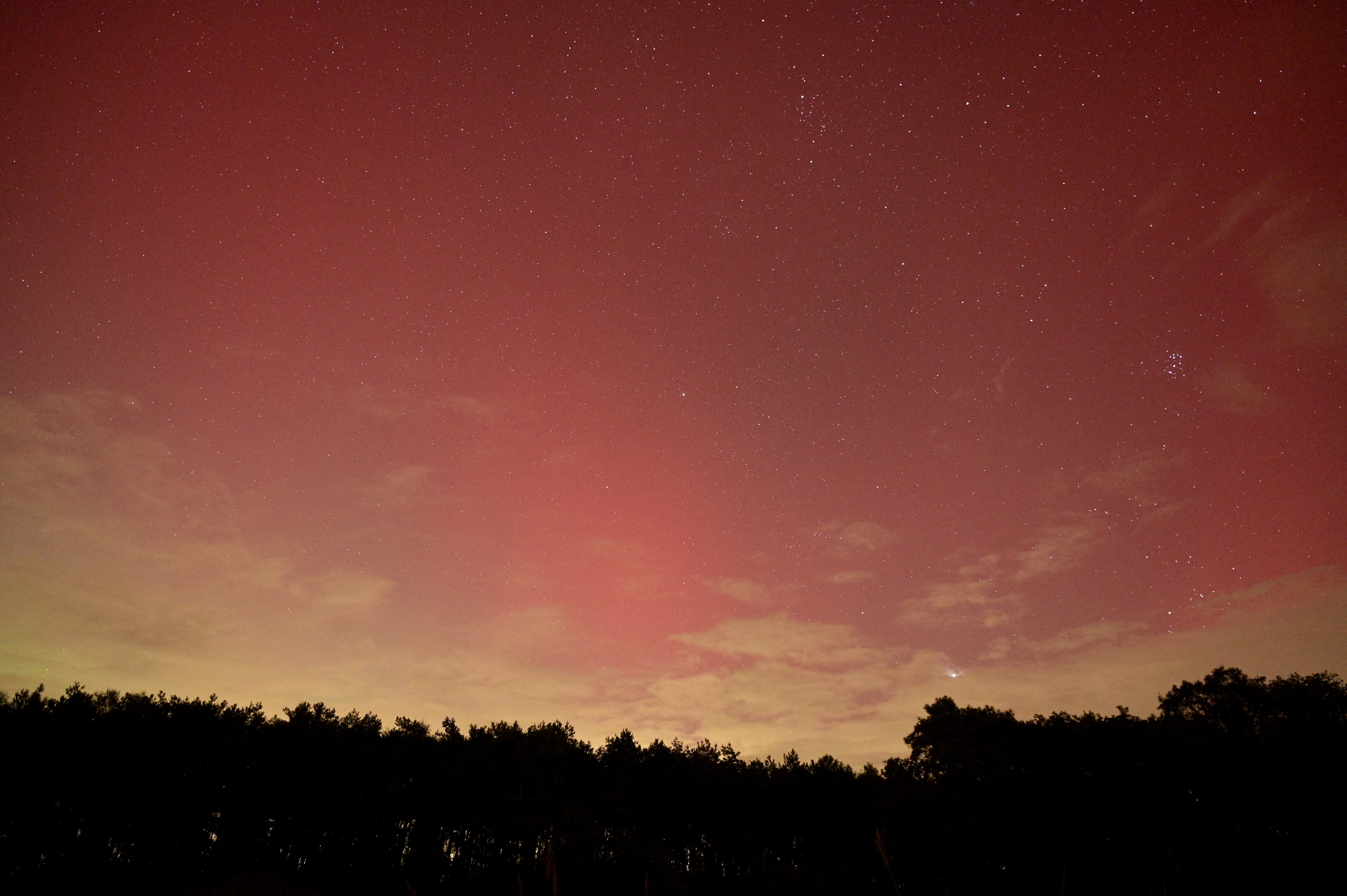
UPDATE - 11 October 2024 at 13:45UTC - The severe geomagnetic storm of last night is apparently coming to its end. Bz (strength of the vertical component of the interplanetery magnetic field) has returned from strongly negative (-46 nT between 22:00 and 00:30UTC) to typical background values of -4 nT around noon on 11 October. The solar wind speed is still high though, with values near 750 km/s. The Kp index (NOAA) was at severe storm levels for 18 consecutive hours (!), and reached only strong levels (Kp=7+) during the most recent interval (09:00-12:00 UTC). The local K index in Belgium (K_BEL, Dourbes) remained at 7 (strong/major storm). The provisional Dst index has reached -335 nT during the 01-02UTC interval on 11 October (Kyoto WDC).
As the geomagnetic field is still recovering from the uppercut it got from the ICME last night, the SIDC forecaster is expecting "... mostly minor to moderate storm conditions, with possible major storm intervals globally and locally in the next 24 hours due to the continued influence of the interplanetary coronal mass ejection (ICME) ... and the possible arrival a mild high-speed stream from ... a coronal hole. ...". This basically means that for Belgium, chances are becoming small to see the aurora again. Observers can use their photographic skills to catch any aurora under dark and clear skies.
Aurora have been photographed as far south as California and Texas in the United States, and from Italy and Greece in Europe (Spaceweather.com). The geomagnetic storm left its mark in numerous other domains, which will be discussed in a new STCE newsitem next week.
